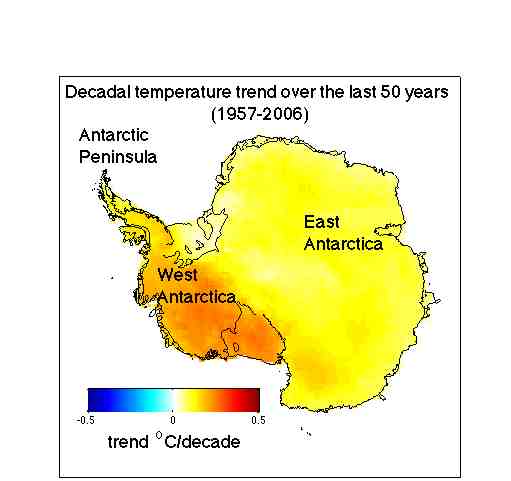Guest post by Mauri Pelto
 It is popularly understood that glaciologists consider West Antarctica the biggest source of uncertainty in sea level projections. The base of the 3000-m thick West Antarctic Ice Sheet (WAIS) – unlike the much larger East Antarctic Ice Sheet – lies below sea level, and it has been recognized for a long time that this means it has the potential to change very rapidly. Most of the grounded West Antarctic ice sheet drains into the floating Ross and Ronne-Filchner ice shelves, but a significant fraction also drains into the much smaller Pine Island Glacier. Glaciologists are paying very close attention to Pine Island Glacier (“PIG” on map, right) and nearby Thwaites Glacier. In the following guest post, Mauri Pelto explains why.
It is popularly understood that glaciologists consider West Antarctica the biggest source of uncertainty in sea level projections. The base of the 3000-m thick West Antarctic Ice Sheet (WAIS) – unlike the much larger East Antarctic Ice Sheet – lies below sea level, and it has been recognized for a long time that this means it has the potential to change very rapidly. Most of the grounded West Antarctic ice sheet drains into the floating Ross and Ronne-Filchner ice shelves, but a significant fraction also drains into the much smaller Pine Island Glacier. Glaciologists are paying very close attention to Pine Island Glacier (“PIG” on map, right) and nearby Thwaites Glacier. In the following guest post, Mauri Pelto explains why.
[Read more…] about Is Pine Island Glacier the Weak Underbelly of the West Antarctic Ice Sheet?
 The paper shows that Antarctica has been warming for the last 50 years, and that it has been warming especially in West Antarctica (see the figure). The results are based on a statistical blending of satellite data and temperature data from weather stations. The results don’t depend on the statistics alone. They are backed up by independent data from automatic weather stations, as shown in our paper as well as in updated work by Bromwich, Monaghan and others (see their AGU abstract,
The paper shows that Antarctica has been warming for the last 50 years, and that it has been warming especially in West Antarctica (see the figure). The results are based on a statistical blending of satellite data and temperature data from weather stations. The results don’t depend on the statistics alone. They are backed up by independent data from automatic weather stations, as shown in our paper as well as in updated work by Bromwich, Monaghan and others (see their AGU abstract,  I often receive letters that range from amusing claims that we are overlooking changes in the magnetic field, to tales about how the “weight” of carbon dioxide keeps it “near the ground”. If the writer sounds serious, then I treat them seriously, and do my best to provide a helpful reply. Often, though, I find myself in a pointless debate of the most basic, well-established physical principles. I generally cut off the discussion at this point, because I simply don’t have the time. This can result in a hostile response accusing me of “having an agenda”. Most would call me naïve for bothering to respond in the first place.
I often receive letters that range from amusing claims that we are overlooking changes in the magnetic field, to tales about how the “weight” of carbon dioxide keeps it “near the ground”. If the writer sounds serious, then I treat them seriously, and do my best to provide a helpful reply. Often, though, I find myself in a pointless debate of the most basic, well-established physical principles. I generally cut off the discussion at this point, because I simply don’t have the time. This can result in a hostile response accusing me of “having an agenda”. Most would call me naïve for bothering to respond in the first place.